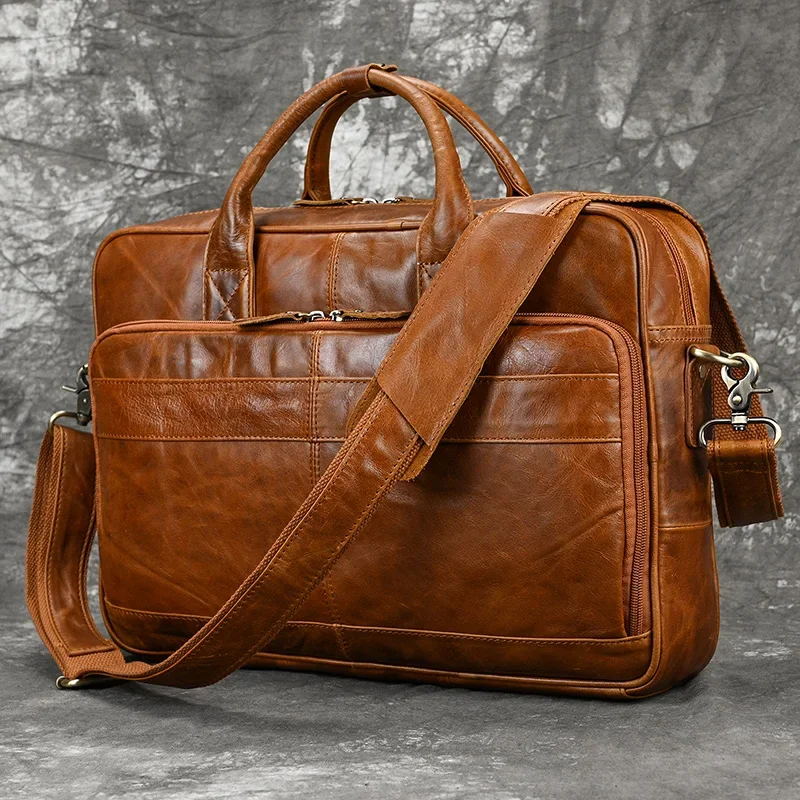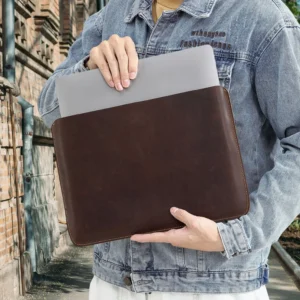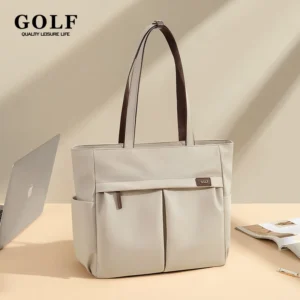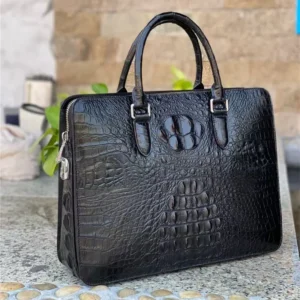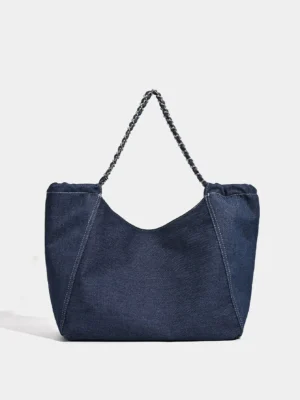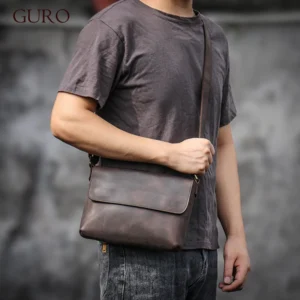Introduction: Navigating Leather Quality for Premium Bags
When shopping for premium leather bags, you’ll quickly encounter a confusing array of terms—full-grain, top-grain, genuine leather, and more. This terminology confusion isn’t accidental; it often serves to obscure true quality differences in the marketplace. Understanding the distinction between full-grain and top-grain leather is essential when investing in a bag that will accompany you for years or even decades.
The quality of leather directly impacts not just how your bag looks initially, but how it performs over time. Your choice affects durability, how the bag ages aesthetically, and ultimately, the value you receive for your investment. Many professionals find themselves disappointed when an expensive purchase fails to stand the test of time simply because they weren’t equipped with the right knowledge.
In this comprehensive guide, we’ll clear up the confusion between these two premium leather types, helping you make an informed decision that aligns with your needs and expectations. The difference between these materials goes far beyond simple marketing—it impacts the very experience of owning and using a timeless classic leather briefcase throughout your professional life.
What is Full-Grain Leather? The Premium Standard
Full-grain leather represents the highest quality leather available for bags and accessories. This premium material comes from the outermost layer of the animal hide—the part directly below the hair. What makes it special is what isn’t done to it: unlike other grades, full-grain leather undergoes minimal processing, preserving the hide’s natural characteristics.
Key characteristics of full-grain leather include:
- Natural markings, growth lines, and small scars remain visible, creating a unique “fingerprint” for each piece
- Complete, intact fiber structure that hasn’t been altered through sanding or buffing
- Dense, tight grain pattern that creates superior strength and durability
- Visible pores that allow the leather to “breathe” and develop character over time
- Natural variations in texture that showcase the material’s authenticity
This leather type requires skilled selection, as tanners must carefully choose hides with minimal serious flaws while accepting the natural characteristics that give the leather personality. Only about 10-15% of all leather produced worldwide qualifies as true full-grain quality.
The preservation of the natural grain means the leather retains its inherent strength. The unaltered fiber structure creates a material that becomes more supple without weakening over time, making it ideal for full-grain messenger bags and other items that experience daily use.
What is Top-Grain Leather? Refined Sophistication
Top-grain leather represents the second-highest quality grade in the leather hierarchy. While it starts with the same outermost layer as full-grain, it undergoes additional processing to create a more refined appearance. This processing fundamentally changes the leather’s characteristics while maintaining many desirable qualities.
Key characteristics of top-grain leather include:
- Surface sanding or buffing to remove natural imperfections and create a more uniform appearance
- Thinner profile due to the removal of the outermost portion of the hide
- Application of a finish coat that adds color consistency and stain resistance
- Artificial grain patterns often embossed to replace the natural grain removed during processing
- Smoother, more consistent texture that appeals to many consumers
The processing techniques make top-grain leather more pliable and easier to work with during manufacturing. This allows for more intricate designs and consistent results across production batches. Many best leather briefcases use top-grain leather when a more uniform, refined appearance is desired.
The finishing applied to top-grain leather creates a protective barrier that offers good resistance to stains and moisture. This makes it practical for everyday use, especially in bags that might be exposed to various environments. However, this same finish prevents the leather from developing the rich patina that many leather enthusiasts prize.
Direct Comparison: Full-Grain vs Top-Grain for Bags
When choosing the perfect leather briefcase or bag, understanding the practical differences between these two leather types becomes crucial. This side-by-side comparison highlights how these differences manifest in daily use:
| Aspect | Full-Grain Leather | Top-Grain Leather |
|---|---|---|
| Durability | Exceptional (10-20+ years with proper care) | Very good (5-10 years with proper care) |
| Initial Appearance | Natural variations, visible pores, authentic character | Smooth, uniform, refined, consistent color |
| Aging Process | Develops rich patina, becomes more supple, shows beautiful wear patterns | Maintains more consistent appearance, less dramatic aging |
| Water Resistance | Naturally water-resistant when properly treated, but shows water spots more readily | Better initial water resistance due to applied finish |
| Maintenance | Requires regular conditioning to maintain optimal condition | Requires less frequent conditioning but may need finish touch-ups |
| Price | Highest price point (typically 30-50% more expensive) | More moderate premium price point |
| Weight | Typically heavier | Usually lighter due to processing |
| Flexibility | Initially stiffer but develops suppleness over time | More immediately flexible and soft |
The practical implications of these differences become apparent in how the bag performs in professional settings. Full-grain leather offers unmatched durability and develops character that tells the story of its use. Top-grain provides a more consistent, refined appearance that maintains its original look longer but with less character development.
Both types significantly outperform lower grades like “genuine leather” or “bonded leather,” which don’t belong in the premium category at all. The choice between full-grain and top-grain ultimately depends on whether you prioritize durability and character development or refined appearance and consistency.
Durability Factors: What Determines Bag Longevity
The superior durability of full-grain leather isn’t just marketing—it’s rooted in the material’s physical structure. When examining classic leather briefcases, understanding these structural differences helps explain why certain bags last for decades while others deteriorate more quickly.
The intact fiber structure of full-grain leather creates exceptional strength in several ways:
- Unaltered collagen fiber bundles maintain their natural cross-linked pattern, maximizing tensile strength
- The density of fibers in the outermost layer provides natural resistance to tearing and punctures
- Natural oils preserved in the leather help prevent cracking and maintain flexibility over time
- Complete grain layer acts as a natural barrier against moisture and environmental damage
- Thickness provides structural integrity at stress points like handles and straps
In contrast, top-grain leather sacrifices some durability for refinement:
- Sanding removes the densest, strongest portion of the hide
- Processing can damage some of the natural fiber structure
- Applied finishes may crack over time, especially at flex points
- Thinner profile provides less material to withstand abrasion and wear
These differences become most apparent at a bag’s stress points—handles, corners, strap attachments, and closure areas. Full-grain leather shows its superiority especially in these high-wear areas, often lasting decades rather than years.

Aesthetic Evolution: How Each Leather Ages
One of the most significant differences between full-grain and top-grain leather lies in how they age over time. This aging process, particularly the development of patina in full-grain leather, represents a fundamental difference in the full-grain vs top-grain leather bags comparison.
Full-grain leather’s aging process includes:
- Development of a rich patina—a warm glow that deepens and enriches the color
- Gradual softening that makes the bag conform to your usage patterns
- Burnishing at edges and high-contact areas, creating a polished appearance
- Unique character marks that tell the story of the bag’s journey
- Enhanced grain visibility that showcases the leather’s natural beauty
In contrast, top-grain leather ages differently:
- More consistent color retention due to applied finishes
- Less dramatic character development over time
- Potential for finish to wear away at high-contact points, revealing lighter color beneath
- Possible cracking of the finish layer rather than natural creasing
- More sudden transition from “like new” to “worn” appearance
Many leather enthusiasts describe full-grain leather as “living”—it evolves and improves with use. Each scratch, mark, and color variation becomes part of the bag’s unique history. Top-grain leather, while still high-quality, aims to maintain its original appearance as long as possible rather than evolve.
This difference explains why vintage full-grain leather bags often command high prices—they’ve developed a character that cannot be replicated through manufacturing processes alone. It’s not just about lasting longer; it’s about becoming more beautiful with time.
Practical Care Requirements: Maintaining Your Leather Investment
Proper maintenance is essential regardless of which leather type you choose, though the specific care routines differ. Following the right care regimen ensures you’ll get the maximum lifespan from your leather bag.
For full-grain leather bags:
- Clean with a soft, damp cloth when soiled, avoiding harsh chemicals
- Condition with quality leather conditioner every 3-6 months depending on use
- Allow to dry naturally if wet, away from direct heat sources
- Use leather-specific protectants sparingly to maintain breathability
- Polish occasionally with a soft cloth to enhance natural luster
For top-grain leather bags:
- Wipe clean with a slightly damp cloth, then dry immediately
- Use conditioners specifically formulated for finished leathers every 6-12 months
- Apply leather protectant more liberally, as the finish can handle it
- Touch up scuffs with appropriate color-matched products
- Clean with leather cleaner rather than just water for more stubborn stains
Both leather types benefit from proper storage:
* Store in dust bags when not in use
* Keep in cool, dry environments away from direct sunlight
* Stuff with acid-free tissue to maintain shape
* Avoid plastic covers which can trap moisture
Common mistakes to avoid include using household cleaners, allowing leather to remain wet, storing in plastic bags, and applying too much conditioner. Understanding proper storing leather bags techniques can significantly extend your bag’s lifespan.
Men's Classic Leather Briefcase, Slim Leather Laptop Briefcase, Slim Leather Portfolio Briefcase
$93.67 Select options This product has multiple variants. The options may be chosen on the product pageLeather Laptop Work Tote, Tan Leather Work Tote, Women's Leather Work Tote, Zippered Leather Work Tote
Price range: $223.62 through $237.97 Select options This product has multiple variants. The options may be chosen on the product pageClassic Laptop Briefcase, Men's Classic Leather Briefcase, Slim Leather Attache Case
Price range: $353.50 through $360.81 Select options This product has multiple variants. The options may be chosen on the product pageBlack Leather Briefcase, Leather Document Bag, Men's Classic Leather Briefcase
Genuine Crocodile Leather Executive Briefcase with Password Lock – Premium Business Document Carrier$1,201.87 Select options This product has multiple variants. The options may be chosen on the product pageCanvas & Leather Messenger Bag, Leather Commuter Tote
$80.41 Select options This product has multiple variants. The options may be chosen on the product pageCrazy Horse Leather Satchel, Men's Leather Satchel, Men's Professional Leather Messenger, Vintage Style Messenger Bag
$132.70 Select options This product has multiple variants. The options may be chosen on the product page
How to Identify Genuine Leather Grades When Shopping
With misleading marketing commonplace in the leather goods industry, knowing how to verify leather quality becomes an essential skill. Here’s how to identify true full-grain and top-grain leather when shopping:
Visual inspection techniques:
* Full-grain leather shows natural variations, visible pores, and subtle imperfections
* Top-grain leather appears more uniform in color and texture, with less visible natural markings
* Examine for artificial embossing patterns that look too perfect or repetitive (indicates corrected grain)
Tactile assessment methods:
* Full-grain feels naturally textured with subtle variations when you run your fingers across it
* Top-grain feels smoother and more consistent to the touch
* Both should feel substantial and not flimsy or plastic-like
Edge examination:
* Look at unfinished edges—full-grain shows tight, dense fibers throughout
* Top-grain edges may appear slightly less dense due to processing
* Lower-quality leathers often show loose fiber structure or layering
Questions to ask retailers:
* “Is this full-grain or top-grain leather?”
* “Where was the leather sourced from?”
* “What type of tanning process was used?”
* “Is the entire bag made from the same grade of leather?”
Be wary of these misleading terms:
* “Genuine leather” (despite sounding premium, it’s actually a lower grade)
* “Real leather” (says nothing about the quality)
* “Premium leather” (meaningless without specifying the grade)
Price expectations serve as a reality check—full-grain leather bags typically start at $300+, while quality top-grain options usually begin around $200+. Anything significantly below these price points likely uses lower-grade materials or cut corners in construction.

Ideal Applications: Matching Leather Type to Bag Style and Use
Different bag styles and use cases naturally align better with specific leather types. Understanding these ideal pairings helps you make the most appropriate choice for your specific needs.
Full-grain leather excels in:
- Travel duffels and weekenders that face rough handling and varied environments
- Messenger bags that develop character through daily use
- Rugged briefcases designed for decades of service
- Heritage-style bags where patina development enhances the aesthetic
- Outdoor-oriented bags exposed to the elements
Top-grain leather shines in:
- Structured formal briefcases where consistent appearance matters
- Sleek laptop bags with modern, minimalist designs
- Lightweight totes where reduced weight improves comfort
- Fashion-forward pieces where consistent color matching is essential
- Bags with intricate detailing that benefits from leather that’s easier to work with
Climate and environment considerations also matter. Humid environments may be harder on full-grain leather without proper care, while top-grain’s protective finish offers some advantages in unpredictable conditions. Those in professional environments where perfect consistency is valued might prefer top-grain’s reliable appearance.
The key is matching your primary priorities with the right leather type. If you value character development and maximum longevity, full-grain is worth the investment. If you prefer consistent appearance and lower maintenance requirements, top-grain offers excellent durable leather briefcase options with less required upkeep.
Value Assessment: Is the Higher Price of Full-Grain Worth It?
The price differential between comparable full-grain and top-grain leather bags typically ranges from 30-50%. This significant difference raises an important question: does the higher quality justify the additional investment?
The long-term value proposition of full-grain leather includes:
- Extended lifespan—often 2-3 times longer than top-grain with proper care
- Better aging characteristics that increase aesthetic appeal over time
- Higher resale value retention, sometimes even appreciating with age
- Reduced replacement frequency, lowering lifetime cost
- Superior performance in demanding conditions
For many professionals, calculating the “cost per use” reveals full-grain as the more economical choice despite the higher initial investment. A $500 full-grain briefcase used daily for 15 years costs about $0.09 per use, while a $300 top-grain bag lasting 7 years costs around $0.12 per use.
However, top-grain provides better value in certain scenarios:
- When budget constraints make the initial investment in full-grain prohibitive
- For styles that follow trends and may be replaced before durability becomes an issue
- When weight is a primary concern (such as for frequent travelers)
- For secondary bags that won’t see daily use
- When a specific finish or consistent appearance outweighs longevity concerns
The environmental impact also deserves consideration—investing in one high-quality bag that lasts decades creates less waste than cycling through multiple lower-quality options. This sustainability aspect adds another dimension to the leather laptop work tote value equation.
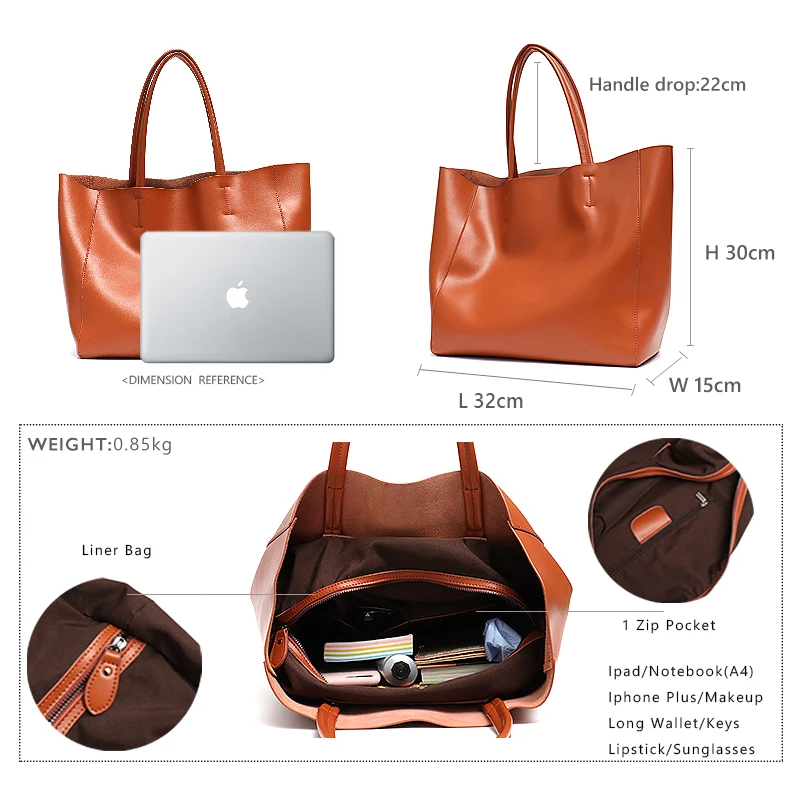
Is Top-Grain Leather Still a Quality Choice for Professional Bags?
Despite the superior attributes of full-grain, top-grain leather remains an excellent material that far surpasses lower-grade options. Understanding its legitimate quality status helps put the comparison in perspective.
Is top-grain leather a quality choice? Absolutely:
- It represents the second-highest grade of leather available
- Offers very good durability that satisfies most professionals’ needs
- Provides consistent appearance valued in formal business environments
- Requires less maintenance than full-grain while still performing well
- Allows for more precise detailing in bag construction
Top-grain leather excels particularly in:
- Lightweight professional bags where reduced weight improves comfort
- Highly structured designs that benefit from its consistent thickness
- Modern, sleek aesthetics where uniformity enhances the design
- Color-matched collections where consistency matters
- Entry-level premium bags that balance quality and affordability
When compared to lower grades like “genuine leather” (a split hide with artificial finishes) or “bonded leather” (essentially leather particles glued together), top-grain remains firmly in the premium category. The benefits of full-grain leather bags are clear, but top-grain represents an excellent compromise between quality and practicality for many professionals.
Final Considerations: Making Your Leather Bag Decision
As you weigh your options between full-grain and top-grain leather bags, consider these final perspectives:
The essential differences come down to longevity, character development, and appearance consistency. Full-grain offers unmatched durability and develops rich character over time, while top-grain provides refined consistency and requires less maintenance.
Evaluate your personal priorities honestly—do you value the story your bag will tell through its developing patina, or do you prefer a bag that maintains its original appearance longer? Is maximum longevity worth the additional investment, or would you rather update your bag more frequently?
Remember that proper care significantly extends the life of either leather type. Even the finest full-grain leather briefcase will deteriorate if neglected, while a well-maintained top-grain bag can serve faithfully for many years.
Finally, consider that leather quality is just one component of a premium bag. Construction methods, hardware quality, and thoughtful design also significantly impact performance and satisfaction. A well-constructed top-grain bag will outperform a poorly made full-grain option every time.
For professionals seeking the perfect balance of quality, style and functionality, exploring various leather messenger bags can help you find the ideal companion for your professional journey.

